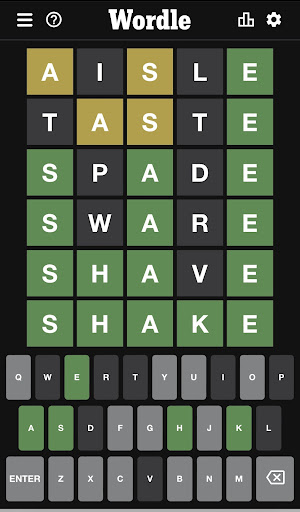Noticed a proliferation of green, yellow, and gray grids on your social media feeds lately? Yeah, us too. They’re the work of Wordle, a viral word game that’s taken the world by storm.
Did all those little grids spark enough curiosity to convince you to give it a try? You’re not alone: Just five months after launch, daily usage has grown exponentially and the game was acquired by the New York Times for over $1 million. (Confession: They totally got me, too.)
But Wordle is not the work of a team of professional product managers. The creator, Josh Wardle, cooked it up at home, by himself, as a fun activity to share with his partner. The game’s breakaway momentum can be attributed to a series of concepts that underpin one of the most popular and effective approaches to modern product management: Wordle is a masterclass in product-led growth.
Let’s explore a few of the product-led strategies powering the rise of Wordle.
It’s easy to get started
First off, Wordle is completely free and accessed exclusively through the web. There’s no app to find and download, no sign-up form to fill out, and no login credentials to enter—all you need to do is type “wordle” into your search bar, click the link, and you’re in. Getting started is a friction-free process.
This is a valuable lesson for any product manager: The less of a lift users have to make to start using a new piece of technology, the more likely they are to actually engage with it, find value, and keep using it.

Wordle is also very easy to learn. Upon first visiting the site, you’re met with an intuitive, uncluttered interface. There’s the game board, an on-page keyboard, and just four buttons: a settings button, a statistics button to see how you’ve been progressing, a question mark-shaped button that opens simple game instructions, and a menu button that opens a side navigation bar promoting the New York Times’ other popular word games.
It sells itself—and other products
Let’s talk about that menu button for a minute. It’s new with the Times acquisition, but it leverages a key concept in product-led growth: Let your product sell itself as much as possible. While Wordle is free, the Times’ popular crossword puzzle and select other games are not. Those who want to take a crack at these other products need an active subscription to the Times’ news website. Presenting the option to play other similar games in-app is a prime opportunity for cross-sell and upsell.
Even engaging with one of the other free games on the menu leads users to a page with a clear call to action to subscribe for more access. And, users tend to return to Wordle again and again, since there’s a new word puzzle each day. That creates daily opportunities to expand users to the Times’ paid offerings. Indeed, the Times now reports that its Wordle acquisition led to “tens of millions of new users.”
Wordle’s social sharing mechanism is also a great example of product-led growth. Allowing users to quickly and easily share their wins to their social feeds from inside the app the moment they complete the puzzle builds natural word-of-mouth momentum for the product. In fact, it’s the primary reason daily usage skyrocketed from less than 5,000 users in October to over 45 million in January.
It’s really sticky
How many of you now wake up each morning to posts on social media reporting the results of Wordle puzzles? How often is it the same people reporting their results, every single day?
Wordle is sticky. Because the puzzle refreshes with a new word and six more guesses each day, there’s an incentive for players to return to the product at a regular cadence. They’re getting value from it in the form of a fun, social challenge and the game’s personal statistics reporting provides a sense of progression and a goal to strive toward.
And, the social aspect that initially led to Wordle’s virality serves a secondary purpose in this case: Seeing your friends post their results each day (in a format that doesn’t spoil the solution, by the way) reminds players that it’s time to go take a crack at the daily puzzle for themselves.
Putting Wordle’s lessons into practice
How can you start leveraging the techniques that led to Wordle’s success to see similar results for your own products? There are a few ways:
Lesson 1: Make your product as easy to adopt as possible
Design effective in-app onboarding that walks users through the basics of usage from the moment they log in, so they start seeing value from the experience fast.
Freemium offerings are another way to reduce barriers to entry for your users. They provide a way to start using a product without engaging in a lengthy sales process or spending any money up front. Once users start seeing value from the product, you’ll have plenty of opportunities to offer them premium features and convert them to paying customers.
Wordle also crosses platforms easily. It works just as well on mobile as it does on desktop devices, so users can pick it up and play wherever and whenever they want. Again, low barriers to entry.
Lesson 2: Let your product do the heavy lifting
Wordle’s simple game design and social sharing feature led to a 900,000% increase in usage and a seven-figure acquisition by a major global news outlet. And Wardle didn’t have to lift a finger to promote Wordle. It all happened organically, driven entirely by user interactions with the product.
Product teams can manufacture a similar automation effect for their own cross-sell, upsell, and expansion initiatives, and to drive feature adoption after releases. Analyzing product usage data can reveal who is interacting with the product in ways that make them an ideal user for the new functionality. Then, you can design in-app messaging to promote the feature and use in-product user behavior as the trigger to automatically display the promotion to only the most relevant users.
In a more literal sense, you can use in-app messaging to encourage your happiest, most successful users to leave positive reviews of your app on the App Store or product review sites.
Well-designed in-app onboarding comes in handy here, too. By bringing your onboarding in-app and automating the process, you’ll free up your customer success team’s time and resources to work on finding ways to bake even more value into the product instead of handling menial support tasks.
Lesson 3: Understand what makes your app sticky and encourage everyone to experience those things
The core dynamics that make Wordle fun—the fresh daily puzzles and ability to share—also make it sticky.
With a good product analytics solution, you can identify the features and behaviors that keep users coming back to your applications, too. The right analytics tool can capture everything that happens in your platform, so you can examine the ways the most successful users are interacting with it.
Once you have those insights, you can use in-app guidance to build out onboarding flows, product tours and walkthroughs, and just-in-time tips to lead all of your app’s other users down the same paths those power users are following.
To mimic the effect of Wordle’s personal statistics reporting feature, consider displaying progress bars or checklists to encourage users to continue working through your onboarding flows. Providing a sense of “Almost there!” and showing users how many other users have completed their training can boost overall completion rates, which lead to better user outcomes.
Wordle might just be a fun web game, but there’s a lot we can learn from its wild success. Admit it: Going from 5,000 users to 45 million in three months is just about every product manager’s wildest dream.
Looking for more ways to use product-led strategies to drive adoption, retention, and growth? Check out Pendo’s Product-Led Resource Hub.


